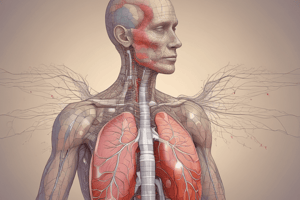Podcast
Questions and Answers
What percentage of oxygen is transported in the body by hemoglobin?
What percentage of oxygen is transported in the body by hemoglobin?
- 7%
- 23%
- 99% (correct)
- 1%
Which method accounts for the least amount of carbon dioxide transport in the circulatory system?
Which method accounts for the least amount of carbon dioxide transport in the circulatory system?
- Transport as hydrogen ions in red blood cells
- Transport as bicarbonate ions
- Transport in the blood plasma (correct)
- Transport by hemoglobin
What role does carbonic anhydrase play in carbon dioxide transport?
What role does carbonic anhydrase play in carbon dioxide transport?
- It converts CO2 into hydrogen ions and bicarbonate. (correct)
- It helps CO2 dissolve in plasma.
- It enhances oxygen binding to hemoglobin.
- It facilitates the release of CO2 into the atmosphere.
What is the combined method of CO2 transport known as when it binds to hemoglobin?
What is the combined method of CO2 transport known as when it binds to hemoglobin?
How does oxygen enter the bloodstream from the alveoli?
How does oxygen enter the bloodstream from the alveoli?
What is the primary factor that enables air to exit the lungs during exhalation?
What is the primary factor that enables air to exit the lungs during exhalation?
Which muscles are primarily responsible for forceful exhalation?
Which muscles are primarily responsible for forceful exhalation?
During inhalation, what happens to the pressure inside the chest?
During inhalation, what happens to the pressure inside the chest?
How do the external intercostal muscles contribute to inhalation?
How do the external intercostal muscles contribute to inhalation?
What role does the diaphragm play during exhalation?
What role does the diaphragm play during exhalation?
What happens to the volume of the thoracic cavity during exhalation?
What happens to the volume of the thoracic cavity during exhalation?
What can cause breathing difficulties related to chest pressures?
What can cause breathing difficulties related to chest pressures?
What is the significance of the internal intercostal muscles during respiration?
What is the significance of the internal intercostal muscles during respiration?
Flashcards
Exhalation
Exhalation
The process of air moving out of the lungs.
Lung Pressure
Lung Pressure
Higher pressure inside the lungs causes air to move out.
Thoracic Cavity Volume
Thoracic Cavity Volume
Changing the size of the chest cavity changes air pressure.
External Intercostal Muscles (Exhalation)
External Intercostal Muscles (Exhalation)
Signup and view all the flashcards
Diaphragm (Exhalation)
Diaphragm (Exhalation)
Signup and view all the flashcards
Inhalation
Inhalation
Signup and view all the flashcards
Inhalation Pressure
Inhalation Pressure
Signup and view all the flashcards
Muscles of Inhalation
Muscles of Inhalation
Signup and view all the flashcards
Oxygen Transport (Dissolved)
Oxygen Transport (Dissolved)
Signup and view all the flashcards
Oxygen Transport (Hemoglobin)
Oxygen Transport (Hemoglobin)
Signup and view all the flashcards
Carbon Dioxide Transport (Plasma)
Carbon Dioxide Transport (Plasma)
Signup and view all the flashcards
Carbon Dioxide Transport (Bicarbonate Ions)
Carbon Dioxide Transport (Bicarbonate Ions)
Signup and view all the flashcards
Carbon Dioxide Transport (Carbaminohemoglobin)
Carbon Dioxide Transport (Carbaminohemoglobin)
Signup and view all the flashcards
Study Notes
Mechanics of Breathing - Exhalation
- Air moves from high pressure to low pressure.
- Exhaling increases pressure inside the lungs, forcing air out.
- Increasing chest cavity volume lowers pressure inside the chest.
- Decreasing chest cavity volume increases pressure inside the chest.
Muscles of Exhalation
- External intercostal muscles: Relax, pulling rib cage down and reducing chest cavity volume, pushing air out of lungs. Located between ribs on the outside of the chest.
- Diaphragm: Relaxes and moves up, further reducing chest cavity volume. Located between abdominal and thoracic cavities.
- Internal intercostal muscles: Contract, increasing pressure on the chest, assisting in forceful exhalation. Located between ribs on the inside of the chest.
- Abdominal muscles: Contract, pushing abdominal contents towards diaphragm, further compressing lungs and expelling air.
Mechanics of Breathing - Inhalation
- Inhalation lowers pressure in the lungs below atmospheric pressure, drawing air in.
- Increasing chest cavity volume lowers pressure, sucking air into lungs.
- If the volume is increased, the air pressure decreases.
- This is an active process that requires the contraction of muscles to increase chest cavity volume.
- Your chest muscles pull your rib cage up and out.
- This process is important to avoid difficulty when breathing.
Muscles of Inhalation
- External intercostal muscles: Contract, pulling rib cage up and increasing chest cavity volume, drawing air into lungs.
- Diaphragm: Contracts and moves downward, increasing chest cavity volume, creating a vacuum that draws air into the lungs.
Transport of Oxygen
- Oxygen is transported in two ways:
- Dissolved gas: A small amount of oxygen dissolves directly into the plasma of oxygen-poor blood in the capillaries of alveoli. This is driven by pressure difference between the alveoli and the blood. Accounts for about 1% of oxygen transport.
- Hemoglobin: A large percentage of oxygen (99%) binds to hemoglobin in red blood cells, forming oxyhemoglobin. This happens inside red blood cells.
Transport of Carbon Dioxide
- Carbon dioxide is transported in three ways:
- Dissolved gas: A small amount dissolves in blood plasma and travels to the lungs for exhalation. Accounts for ~7% of transport.
- Bicarbonate ions: The majority (about 70%) of CO2 is converted to bicarbonate ions in red blood cells via carbonic anhydrase. These ions are transported in the blood.
- Carbaminohemoglobin: About 23% of CO2 binds to hemoglobin, forming carbaminohemoglobin and is transported to the lungs.
Studying That Suits You
Use AI to generate personalized quizzes and flashcards to suit your learning preferences.




